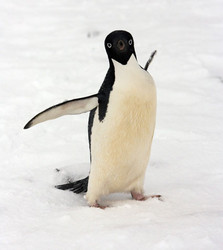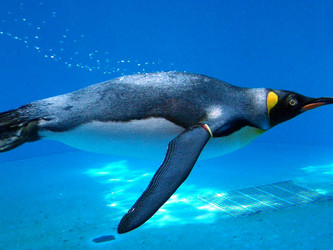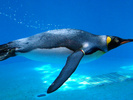Sphenisciformes
Spheniscidae
Penguins



This tree diagram shows the relationships between several groups of organisms.
The root of the current tree connects the organisms featured in this tree to their containing group and the rest of the Tree of Life. The basal branching point in the tree represents the ancestor of the other groups in the tree. This ancestor diversified over time into several descendent subgroups, which are represented as internal nodes and terminal taxa to the right.

You can click on the root to travel down the Tree of Life all the way to the root of all Life, and you can click on the names of descendent subgroups to travel up the Tree of Life all the way to individual species.
For more information on ToL tree formatting, please see Interpreting the Tree or Classification. To learn more about phylogenetic trees, please visit our Phylogenetic Biology pages.
close boxSummary phylogenetic hypothesis based on the combined analysis of morphological, breeding, and mitochondrial DNA characters (Bertelli and Giannini, 2005). All genera are clearly reciprocally monophyletic, however the root of the penguin tree is still unclear. The Snares Penguin, Eudyptes robustus, is now considered conspecific with the Fjordland Penguin, Eudyptes pachyrhynchus, and the Royal Penguin, Eudyptes schlegeli, is now considered conspecific with the Macaroni Penguin, Eudyptes chrysolophus (Christidis & Boles 2008).
References
Baker, A. J., S. L. Pereira, O. P. Haddrath, and K.-A. Edge. 2006. Multiple gene evidence for expansion of extant penguins out of Antarctica due to global cooling. Proceedings of the Royal Society B: Biological Sciences 273(1582):11-17.
Bertelli, S., and N. P. Giannini. 2005. A phylogeny of extant penguins (Aves: Sphenisciformes) combining morphology and mitochondrial sequences. Cladistics 21: 209-239.
Christidis, L. and W. Boles. 2008. Systematics and Taxonomy of Australian Birds. CSIRO Publishing, Collingwood, Australia.
Clarke, J. A., E. B. Olivero, and P. Puerta. 2003. Description of the earliest fossil penguin from South America and first Paleogene vertebrate locality of Tierra del Fuego, Argentina. American Museum Novitates 3423:1-18.
Dann, P., I. Norman, and P. Reilly, eds. 1995. The Penguins: Ecology and Management. Surrey Beatty & Sons, Sydney.
Davis, L. S. and J. Darby, eds. 1990. Penguin Biology. Academic Press, San Diego.
Giannini, N. P., and S. Bertelli. 2004. Phylogeny of extant penguins based on integumentary and breeding characters. The Auk 121: 422-434.
Gill, F. and M. Wright. 2006. Birds of the World: Recommended English Names. Princeton NJ: Princeton University Press.
Grant, W. S., D. C. Duffy, and R. W. Leslie. 1994. Allozyme phylogeny of Spheniscus penguins. The Auk 111: 716-270.
Marchant, S. and P. J. Higgins, eds. 1990. Handbook of Australian, New Zealand and Antarctic Birds. Vol 1. Oxford University Press, Melbourne.
Müller-Schwarze, D. 1984. The behavior of penguins: adapted to ice and tropics. State University of New York Press, Albany.
Nelson, J. B. 2006. Pelicans, Cormorants, and Their Relatives: The Pelecaniformes. Bird Families of the World. Oxford University Press, Oxford, New York.
O’Hara, R. J. 1989. An estimate of the phylogeny of the living penguins (Aves: Spheniscidae). Am. Zool. 29, 11A.
Raikow, R. J., L. Bicanovsky, and A. H. Bledsoe. 1988. Forelimb joint mobility and the evolution of wing-propelled diving in birds. Auk 105:446-451.
Reilly, P. 1994. Penguins of the World. Oxford University Press.
Schreiweis, D. O. 1982. A comparative study of the appendicular musculature of penguins (Aves: Sphenisciformes). Smithsonian Contrib. Zool. 341:1-46.
Simpson, G. G. 1946. Fossil Penguins. Bull. Am. Mus. Nat. Hist. 87, 1–100.
Simpson, G. G. 1972. Conspectus of Patagonian fossil penguins. Am. Mus. Nov. 2488, 1–37.
Simpson, G. G. 1976. Penguins: Past and Present, Here and There. Yale University Press, New Haven.
Stonehouse, B. 1975. The biology of penguins. University Park Press, Baltimore.
Williams, T. D. 1995. The Penguins. Oxford University Press, New York.
Woehler, E. J. 1993. The Distribution and Abundance of Antarctic and Subantarctic Penguins. University Printing Services, Cambridge.
Zusi, R. L. 1975. An interpretation of skull structure in penguins. In: Stonehouse, B. (Ed.), The Biology of Penguins. University Park Press, Baltimore, MD, pp. 59–84.
Information on the Internet
- International Penguin Conservation Work Group
- Antarctica: Valued, Protected, Understood: Penguins. Australian Government Antarctic Division.
- Order Sphenisciformes. Animal Diversity Web.
- Penguins InfoBook. SeaWorld/Busch Gardens.
- Adaptation. The Case of Penguins. Visionlearning.
- New Zealand Penguins
- Falklands.net
- Falklands Penguins
- Nature: The World of Penguins. PBS.
- KidZone: Penguins
- Penguins Around the World
- Pete & Barb's Penguin Pages
- PenguinWorld.com
Title Illustrations

| Scientific Name | Pygoscelis adeliae |
|---|---|
| Location | Antarctica |
| Specimen Condition | Live Specimen |
| Source | happy to see you |
| Source Collection | Flickr |
| Image Use |
 This media file is licensed under the Creative Commons Attribution-NonCommercial-NoDerivs License - Version 2.0. This media file is licensed under the Creative Commons Attribution-NonCommercial-NoDerivs License - Version 2.0.
|
| Copyright | © 2005 robert bingham |
| Scientific Name | Aptenodytes patagonicus |
|---|---|
| Location | captive at Nagasaki Penguin Aquarium, Japan |
| Specimen Condition | Live Specimen |
| Behavior | diving |
| Source | Nagasaki Penguin Aquarium |
| Source Collection | Flickr |
| Image Use |
 This media file is licensed under the Creative Commons Attribution License - Version 2.0. This media file is licensed under the Creative Commons Attribution License - Version 2.0.
|
| Copyright | © 2005 Kanko |
| Scientific Name | Eudyptes pachyrhynchus |
|---|---|
| Location | Snares Islands, North East Island, Station Cove, New Zealand |
| Specimen Condition | Live Specimen |
| Source | Image:SnaresPenguin_(Mattern)_large.jpg |
| Source Collection | Wikimedia Commons |
| Image Use |
 This media file is licensed under the Creative Commons Attribution License - Version 2.5. This media file is licensed under the Creative Commons Attribution License - Version 2.5.
|
| Copyright | © 2004 Thomas Mattern, Department of Zoology, University of Otago, Dunedin, New Zealand |
About This Page
Correspondence regarding this page should be directed to Joseph W. Brown at
josephwb@umich.edu
Page copyright © 2005 Joseph W. Brown
 Page: Tree of Life
Sphenisciformes. Spheniscidae. Penguins.
The TEXT of this page is licensed under the
Creative Commons Attribution-NonCommercial License - Version 3.0. Note that images and other media
featured on this page are each governed by their own license, and they may or may not be available
for reuse. Click on an image or a media link to access the media data window, which provides the
relevant licensing information. For the general terms and conditions of ToL material reuse and
redistribution, please see the Tree of Life Copyright
Policies.
Page: Tree of Life
Sphenisciformes. Spheniscidae. Penguins.
The TEXT of this page is licensed under the
Creative Commons Attribution-NonCommercial License - Version 3.0. Note that images and other media
featured on this page are each governed by their own license, and they may or may not be available
for reuse. Click on an image or a media link to access the media data window, which provides the
relevant licensing information. For the general terms and conditions of ToL material reuse and
redistribution, please see the Tree of Life Copyright
Policies.
- First online 15 December 2005
- Content changed 22 August 2008
Citing this page:
Tree of Life Web Project. 2008. Sphenisciformes. Spheniscidae. Penguins. Version 22 August 2008 (temporary). http://tolweb.org/Spheniscidae/26387/2008.08.22 in The Tree of Life Web Project, http://tolweb.org/






_large.250a.jpg)


_large.100a.jpg)

 Go to quick links
Go to quick search
Go to navigation for this section of the ToL site
Go to detailed links for the ToL site
Go to quick links
Go to quick search
Go to navigation for this section of the ToL site
Go to detailed links for the ToL site